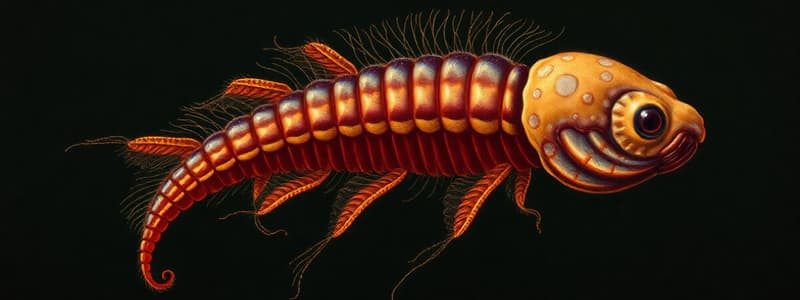Podcast
Questions and Answers
What is the defining characteristic of adults belonging to the Trematoda class?
What is the defining characteristic of adults belonging to the Trematoda class?
- They have segmented bodies.
- They possess three distinct suckers.
- They exhibit hermaphroditism. (correct)
- They have a coiled posterior end.
Which of the following parasites has a minute pyriform shape with a broad rounded posterior part?
Which of the following parasites has a minute pyriform shape with a broad rounded posterior part?
- Diphyllobothrium latum
- Schistosoma mansoni
- Heterophyes heterophyes (correct)
- Taenia saginata
Which parasite is known for having separate sexes among adults?
Which parasite is known for having separate sexes among adults?
- Schistosoma spp. (correct)
- Fasciola
- Diphyllobothrium latum
- Enterobius vermicularis
What describes the appearance of Enterobius vermicularis?
What describes the appearance of Enterobius vermicularis?
What is the method of reproduction in Trichuris trichiura?
What is the method of reproduction in Trichuris trichiura?
What is a unique feature of the class Cestoda?
What is a unique feature of the class Cestoda?
Which statement describes the appendages of the male Schistosoma?
Which statement describes the appendages of the male Schistosoma?
How do filarial worms primarily reproduce?
How do filarial worms primarily reproduce?
Which stage does Giardia exhibit as part of its life cycle?
Which stage does Giardia exhibit as part of its life cycle?
What type of organism is classified under Mastigophora and is known for flagellate movement?
What type of organism is classified under Mastigophora and is known for flagellate movement?
Flashcards
Trematodes
Trematodes
A class of parasitic flatworms with a leaf-like structure and a hermaphroditic reproductive system.
Fasciola (Trematoda)
Fasciola (Trematoda)
A parasitic flatworm with a leaf-like structure and a hermaphroditic reproductive system. It has an intermediate host, meaning its life cycle involves multiple hosts.
Schistosoma spp. (Trematoda)
Schistosoma spp. (Trematoda)
Parasitic flatworms known for separate sexes. The female is long and cylindrical, while the male has a characteristic flattened posterior part with a Gynaecophoric canal to hold the female.
Heterophyes heterophyes (Trematoda)
Heterophyes heterophyes (Trematoda)
Signup and view all the flashcards
Cestoda (Tapeworms)
Cestoda (Tapeworms)
Signup and view all the flashcards
Diphyllobothrium latum (Cestoda)
Diphyllobothrium latum (Cestoda)
Signup and view all the flashcards
Trichuris trichiura (Nematoda)
Trichuris trichiura (Nematoda)
Signup and view all the flashcards
Filariae (Nematoda)
Filariae (Nematoda)
Signup and view all the flashcards
Giardia (Mastigophora)
Giardia (Mastigophora)
Signup and view all the flashcards
Leishmania (Mastigophora)
Leishmania (Mastigophora)
Signup and view all the flashcards
Study Notes
Parasites Introduction & Classification
- Parasites are organisms that live in or on another organism (the host) and benefit from the relationship, while the host is harmed.
- Parasites are classified into different groups.
- Classification includes Trematodes, Cestodes, Nematodes, and Protozoa.
Trematodes
- Trematodes are a type of flatworm. They are often leaf-like in shape.
- Some Trematodes include Fasciola, Schistosoma spp..
- Fasciola: Adults have a leaf-like structure, are hermaphrodites, and have an intermediate host.
- Schistosoma spp.: Adults have separate sexes; the female is long, cylindrical, and smooth; the male's anterior portion is cylindrical and the posterior flattened and has a gynaecophoric canal.
- Schistosoma mansoni: Includes both the adult and cercaria forms.
Cestodes
- Cestodes are segmented flatworms. They are attached to the lining of the intestine.
- Examples include Diphyllobothrium latum and Taenia saginata.
- Diphyllobothrium latum: Segmented and hermaphrodites.
- Taenia saginata: Segmented and hermaphrodites.
Nematodes (Roundworms)
- Nematodes are unsegmented roundworms.
- Examples include Ascaris lumbricoides, Trichuris trichura, Enterobius vermicularis, Ancylostoma duodenale, and Wuchereria bancrofti.
- Ascaris lumbricoides: A type of roundworm.
- Trichuris trichura: Whip-like shape, males have a coiled posterior end with a long spicule; females have a simple posterior end.
- Enterobius vermicularis: Fusiform shape with thin pointed tail at the posterior ⅓.
- Ancylostoma duodenale: A parasitic nematode found in the small intestine.
- Wuchereria bancrofti: A filarial worm that causes lymphatic filariasis, a parasitic roundworm.
Protozoa
- Protozoa are single-celled eukaryotic organisms.
- Examples include Giardia, Leishmania, Entameoba, and Plasmodium.
- Giardia: Differentiated into cyst and trophozoite.
- Leishmania: Differentiated into amastigote and promastigotes.
- Entameoba: Includes cyst and trophozoite forms.
- Plasmodium: Has ring-stage, schizont, merozoites, and gametocytes forms.
Arthropods with Medical Importance
- Anopheles mosquito: A vector for malaria (Class Insecta). Has 3 pairs of legs, one pair of wings, and an elongated mouth part.
- Sandfly: A vector for Leishmania (Class Insecta). Characterized by a hairy body and wings, and sandy yellow color.
- Flea: A vector for Hymenolepis nana and the plague (Class Insecta). They have no wings with long legs to jump, and are blood-sucking.
- Lice: A vector for some bacterial infections (Class Insecta). They have three pairs of legs, are wingless, and attach to hair.
- Mites: Sarcoptes scabiei (itch mite) causes Scabies.
- Cyclops: A type of copepod, a small crustacean. A vector for some parasitic worms.
Studying That Suits You
Use AI to generate personalized quizzes and flashcards to suit your learning preferences.




